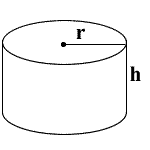Cylinder surface area, volume, lateral area calculator
The rotational body formed by the surface formed by rotating the other three sides 360° with the straight line on one side of the rectangle as the rotation axis is called a cylinder. That is, the geometric body obtained by rotating 360° with one side of the AG rectangle as the axis is a cylinder.

Volume V = πr2h
Lateral area L = 2πrh
Bottom area T = B = πr2
Surface area A = L + T + 2B = 2πrh + 2(πr2) = 2πr(h+r)
A Cylinder Surface Area, Volume, and Lateral Area Calculator is a tool designed to calculate the surface area, volume, and lateral area of a cylinder. You typically input the radius of the cylinder's base and its height to get these measurements.
Why Use a Cylinder Surface Area, Volume, and Lateral Area Calculator?
This calculator is useful for determining the size and capacity of cylindrical objects. It's commonly used in various fields like engineering, construction, packaging, and design. For example:
- Surface Area is important for determining the amount of material needed to cover the outside of a cylinder (e.g., wrapping a cylindrical package).
- Volume is used for determining the amount of space inside a cylinder (e.g., how much liquid a cylindrical tank can hold).
- Lateral Area is helpful for calculating the surface area of just the sides of the cylinder (excluding the top and bottom).
How It Works:
The formulas used to calculate these three properties are based on the cylinder's radius rr r (the radius of the base) and height h.
-
Surface Area:
Atotal=2πr2+2πrh
The total surface area of a cylinder is the sum of the areas of the two circular bases and the lateral surface (side). The formula is:Where:
- AtotalA_{\text{total}} A total is the total surface area,
- rr r is the radius of the base,
- hh h is the height of the cylinder.
-
Volume:
V=πr2h
The volume of a cylinder represents the amount of space inside it. It is calculated as:Where:
- V is the volume,
- r is the radius of the base,
- h is the height of the cylinder.
-
Lateral Area:
Alateral=2πrh
The lateral area is the area of just the side of the cylinder, not including the top and bottom. The formula is:Where:
- Alateral is the lateral area,
- r is the radius of the base,
- h is the height of the cylinder.
If you are given the diameter dd d instead of the radius, you can use the following relationship:
- Radius r=d/2
When to Use It:
You would use this calculator in any situation where you need to quickly determine:
- The surface area of a cylindrical object (e.g., designing cylindrical tanks, pipes, or packaging materials).
- The volume of a cylinder (e.g., calculating how much liquid a cylindrical container can hold).
- The lateral area of a cylinder (e.g., to find the amount of paint needed for just the side of a cylindrical object).